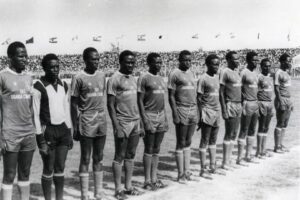Uganda will mark 62 years of independence on Wednesday, October 9, 2024, which will be celebrated at Busiko Teachers’ Training College in Masafu town council, Busia district, under the theme A Recommitment to Secure and Fortify Our Destiny is Anticipated to Draw Ugandans from Diverse Backgrounds. The monumental occasion will be celebrated with an array of milestones and testimonies that highlight the journey from 1962 to date.
Much as there is a lot to celebrate in the spheres of politics, social, and economic, there is much more to talk about in football since 1962.
In the same year, after attaining independence, Uganda qualified for the first Africa Cup of Nations (AFCON) in 1962, and 62 years on, Ugandan football has seen significant evolution since the country’s independence, growing from a developing sport into the main sport in Uganda.
Football continued to be a popular sport, influenced by colonial British institutions, and this explains why the football national team commonly known as the Uganda Cranes has always had white men as coaches, with the first qualification to the AFCON being spearheaded by Peter Okee, a white coach. Peter Okee was a prominent figure in Ugandan football during this period, guiding the Uganda Cranes to one of its most successful eras. In fact, we have become accustomed to celebrating Ugandan football’s greatest feats as the years pass by.
In the early 1960s, the Uganda national team participated in regional tournaments like the Gossage Cup, now the CECAFA Cup, which was the primary competition in East Africa.
Uganda consistently started coming out outstanding by consistently competing with other East African teams like Tanzania and Kenya.
The political instability and economic struggles between 1971 and 1979 during Idi Amin’s reign saw a decline in Uganda’s football. Many talented players during this period left for opportunities abroad, and football infrastructure began to worsen. However, Uganda was able to qualify for the 1978 AFCON finals, where it managed to come in the second position after losing to Ghana 2-0, a tournament that saw Phillip Omondi among the tournament top scorers with 3 goals.

In the 2000s, football in Uganda began to revitalize, with increased efforts to improve professionalism in the domestic league and better management of the national team.
After a 39-year period without qualifying for AFCON, the Uganda Cranes qualified for the 2017 edition, justifying the national team’s revival on the African football scene. Additionally, they also qualified for the 2019 edition.
Nonetheless, Uganda has made significant strides in the Federation of International Football Association (FIFA) rankings, and its highest FIFA world ranking in football was 62nd, which was achieved in 2015. This manifested a time of improved performances, especially in regional and continental competitions, with increased competitive match wins in the CECAFA Cup and AFCON qualifiers. As a result, Uganda has frequently been among the top in East Africa, currently ranking higher than Kenya, Rwanda, and Tanzania.
In addition, there has been a significant improvement in football infrastructure, including stadium upgrades and efforts to build better training facilities, with the current development coming with the most recent refurbishment of the Mandela National Stadium, which is Confederation of African Football (CAF) certified.
Other stadiums, including the Hoima city’s (20,000) seating capacity and Akii-Bua Stadiums, are being developed; these projects reflect Uganda’s commitment to improving its infrastructure, especially ahead of its co-hosting of AFCON 2027.
Uganda’s co-hosting of AFCON 2027 is a testament to the country’s efforts in improving football infrastructure, governance, and its regional standing. Investing in stadiums, improved football management, successful hosting of previous regional tournaments, national team success, and improved security within the country have all contributed to Uganda’s ability to co-host AFCON. Co-hosting allows Uganda to showcase itself as a viable football destination on the continental stage.
The national team’s milestones are entirely attributed to the government’s increased funding. For instance, the government has over the past 10 years increased the football budget from just UGX 4bn to the current financial year 2024/25 budget being UGX 17bn, and thus the standards of the game are improving steadily.
Several Ugandan footballers have over the years had outstanding careers and represented Uganda abroad in different leagues around the world, with the most recent being Denis Onyango, who plays for Mamelodi Sundowns, where he has won multiple league titles, the Confederation of African Football (CAF) Champions League, and the 2016 CAF Africa Player of the Year.
Football in Uganda continues to grow, with increasing investments in both grassroots and professional football. The focus on youth development, professionalism, and women’s football is expected to shape its future trajectory.